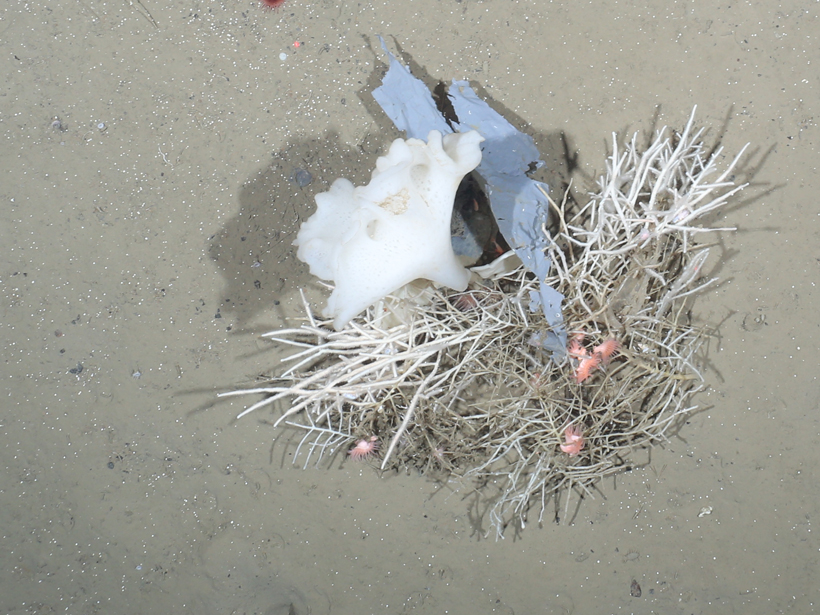Litter isn’t only a problem on land—it’s also found deep in the ocean. Despite an international treaty banning waste disposal at sea, trash from illegal dumping, commercial fishing, and maritime accidents has accumulated on the ocean floor. Now scientists have analyzed thousands of photographs of a swath of the bottom of the Arctic Ocean taken between 2002 and 2014 and calculated changes in marine litter over time. The results are troubling: The litter has become 4 times denser since 2004, and in one place its density has shot up 23-fold.
Litter, Litter Everywhere
Mine Tekman, a marine scientist at the Alfred Wegener Institute Helmholtz Centre for Polar and Marine Research in Bremerhaven, Germany, and her group conducted this census of litter on the ocean bottom off the coast of Greenland. “A key strength of this study is its relatively long-term [analysis of debris],” said Chelsea Rochman, an ecologist at the University of Toronto in Canada who was not involved in the study.
The ocean covers more than 70% of Earth’s surface, but “the deep sea is still one of the least studied ecosystems on the planet,” Rochman continued.
Litter is more likely to persist on the deep seafloor because it is shielded from solar radiation.
As coastal cities grow and more ships ply the world’s cargo routes, marine litter is piling up in places, including the Mediterranean Sea and the Indian Ocean. However, only a limited number of investigations have focused on changes in litter density over time.
Some marine litter is readily visible—like the trash in the ocean’s five enormous floating garbage patches—but a lot of it sinks because it’s denser than water. This “invisible” litter, in addition to being harder to clean up, is also more likely to persist on the deep seafloor because it is shielded from solar radiation, which can promote decomposition.
Thousands of Pictures
On expeditions between 2002 and 2014, the researchers towed an underwater camera on a 2500-meter-long cable in Fram Strait near HAUSGARTEN observatory, a 21-station underwater Arctic research base. They programmed the camera to take a picture every 30 seconds, using strobe lights to illuminate the muddy seafloor. Tekman and her team then manually examined all 7058 images to look for litter. They found garbage—mostly plastic, glass, metal, rope, and fabric—in 82 of the images, they reported this month in Deep Sea Research, Part I: Oceanographic Research Papers.
The team determined the litter density for each year’s observations by calculating the number of pieces of litter per square kilometer of seafloor. Tekman and her collaborators calculated litter densities separately for images obtained near two of the HAUSGARTEN observatory stations and obtained values ranging from 390 items per square kilometer to 7710 items per square kilometer. These densities were, on average, significantly higher than those recorded in the Atlantic and Indian Oceans by another research group. This discrepancy might be explained by the complex seafloor topography of Fram Strait, which could cause litter to accumulate there, Tekman hypothesized.
Dramatic Increase

The researchers next investigated how litter densities changed over time. Near HAUSGARTEN observatory’s N3 station, they found that the annual litter density increased by a factor of 23 between 2004 and 2014. Tekman and her team suggest that sea ice near this station may be responsible for the dramatic increase in litter. “Small-sized plastics may have been released from sea ice during melting events,” said Tekman. The increase at the other station was less dramatic—roughly fourfold—but still a cause for worry, the researchers contend. “Humans have invaded the Arctic with their litter,” said Tekman.
The team also investigated how marine life was interacting with the 89 pieces of litter in the images. They found that creatures such as sea anemone, shrimp, and sponges were in, on, or around more than 50% of the litter. The researchers caution that such interactions aren’t always benign. When animals become entangled in litter, the litter can scrape their tissues or even cause these tissues to die, said Tekman.
The scientists are now gathering data about the global distribution of marine litter, a project they hope will reveal more information about the health of the world’s ocean.
—Katherine Kornei (email: [email protected]; @katherinekornei), Freelance Science Journalist
Correction, 27 February 2017: An image caption in an earlier version of this article incorrectly identified a marine organism on the sea bottom. The mention of that organism has been removed from the caption.
Citation:
Kornei, K. (2017), Mounting litter spotted on Arctic seafloor, Eos, 98, https://doi.org/10.1029/2017EO067959. Published on 16 February 2017.
Text © 2017. The authors. CC BY-NC-ND 3.0
Except where otherwise noted, images are subject to copyright. Any reuse without express permission from the copyright owner is prohibited.

